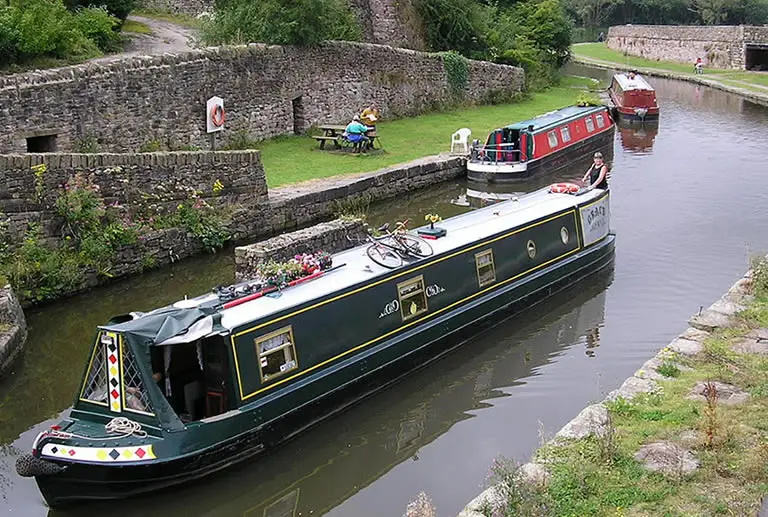Canal boat holidays offer a great relaxing way to spend time with family or friends while enjoying views of rolling countryside and picturesque towns and villages. A canal boat holiday offers much more than just spending time on the water though. There are a lots of things to do in the towns and villages you pass on your way.
Contents
What a canal boat vacation has to offer you
In Europe it is not only the natives that enjoy canal boat holidays so much that they come back for more year after year. Americans who get a taste for narrowboat vacationing tend to get hooked on this form of boating as well.
So regardless of what nationality you are a canal boat holiday has something to offer you.
There are many reasons to use a canal boat for downtime and here are a few.
1. A taste of history
In the British Isles (the UK and Ireland) canals are plentiful. However, unlike the canals in America, and many in Europe, British and Irish canals tend to be very narrow and shallow.
Man-made canals were original built in Europe and Britain thousands of years ago by the Romans for irrigation and to connect rivers.
It was not until the 18th Century that they were used for the transportation of freight, before the dawn of modern transportation methods. However, they proved to be so cost-effective and efficient that in Britain their commercial use continued right up to WWII.
Soon after the Second World War canal systems fell into disrepair until the 1960’s when canal boating started to grow as a leisure activity. By 1970 groups of volunteers were restoring canals throughout the British countryside. To this day canals are still being repaired across the large canal network in the UK.
Originally canal boats were horse-drawn. One or two horses would be tethered to a canal boat to pull it. Along each canal there is a towpath were the horse would be guided as it pulled the boat. Horse-drawn canal boats were still being sparsely used in the 1950s until diesel boats eventually took over.
It is not surprising then that canals run past some very interesting sites and just journeying down a canal can feel like a trip through history.
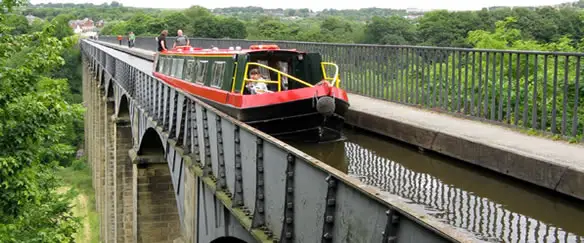
2. See the sights
Because canals were built to be trade routes they link many towns and sites of historical importance. These include castles, heritage sites, museums and old towns and villages.
The Canals & River Trust in Britain owns over 3000 historical sites that include ancient aqueducts, tunnels and even an amazing boat lift designed to lift a canal boat 50 feet from the River Weaver to the Trent & Mersey Canal.
There are many castles, stately homes and nature reserves throughout the country that are within walking distance of canals.
3. See the countryside
There is no better way to see the beautiful countryside of Ireland, Britain and Europe than on a canal boat.
Cruising down a canal at a leisurely pace on a bright, warm summer day is an experience you will remember and treasure for a lifetime.
4. Walk along the towpath
People walking along the towpath is a common sight. It is just as enjoyable to take a leisurely stroll down it as it is to boat alongside it.
Most sights worth seeing are within walking distance of the towpath and towns and villages will usually be only a short walk away as well.
5. Bring your bike
If you wish to see sights a little farther afield than you are willing to walk then why not use a bike?
A great many of the towpaths that run parallel to the canals are bike friendly. Using a bike to see nearby sights and the countryside is a great way to increase the pleasure you get from a canal boat holiday.
There will usually be enough room to store bikes on the deck of a canal boat, especially a narrowboat, but be sure to secure them against theft if left out in the open.
Also be careful storing bikes on the roof of the boat as some tunnels and bridges will have insufficient clearance and you will end-up damaging the bikes. In these situation your boat insurance will not cover the damage and you will be liable for repairs or replacements.
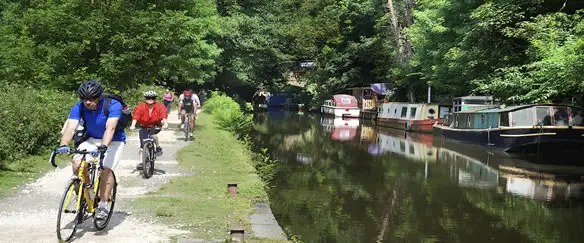
6. Fishing on the canal
Fishing on canals is very popular. You will need to obtain a permit though. A permit is called a license in Europe.
The organization through which you hire your canal boat will be able to advise you how to obtain such a license and may be able to sort the details out for you. Be sure to do this before you start your vacation as it may take time to issue you one. This is especially important if you are travelling to your destination from another country, such as the USA.
A fishing license in Scotland, Wales, England and Ireland (different for all countries) is super cheap at about £12 (about $15) for a week. If you plan to move from one country to another, for example Scotland to England or Northern Ireland to the Republic of Ireland, then you will need seperate fishing licenses for each country.
Be aware that fishing without a license in the UK carries a fine of up to £2,500 (about $3,200)! So don’t be tempted to fish without one.
7. Enjoy a taste of larger
Believe it or not there are no restrictions on consuming alcohol on a narrowboat in the UK or Ireland. So you will often see people sipping on an alcoholic beverage on their boat when the sun is shining. This is not the case in different countries so if you plan to take a canal boat trip in other parts of Europe be sure to check the local regulations.
Drinking and operating a boat while over-the-limit in the USA is illegal. So no drinking and boating on US canals.
If you do plan to have a “tipple” on your canal boat we advise you to ensure that whoever is steering the boat is considered the designated-driver and should therefore not drink. If you crash the boat while under the influence of alcohol the insurance will not cover you and you will be liable for an expensive repair bill.
If you want to a have drink on your canal boat, moor it first or, better still, head to a canalside pub!
8. Visit a canalside inn or cafe
If drinking on the boat isn’t your bat then you can stop-off at any one of the many canalside inns that litter the canal networks of the British Isles.
These old taverns were built to service the thirsty canal boat operators of days-gone-by and now act as stopping points for hungry and thirsty boaters to grab a bite of lunch or just sip beer and wine in the summer sun.
If you don’t drink then don’t worry as there are also plenty of canalside cafes too, though most pubs will serve food, soft drinks and hot beverages as well as alcohol.
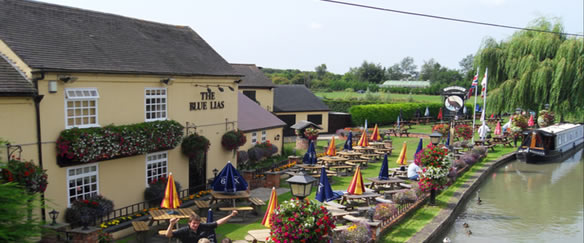
9. Visit a gathering or festival
Festivals and gatherings are held at different points along the canal network and at different times of the year, with the summer being the most popular.
Some music festivals are organised locally while others are national events.
Be sure to check the calendar of events before you book your holiday so that you can enjoy at least one of these.
10. Go shopping
Canal boat holidays have become so popular that many gift shops have sprung up along the canals. But the shops aren’t limited to simple gift ideas.
Along the canal network you will find many art galleries showcasing local and national artists’ pieces with price tags ranging from the affordable to the ridiculous.
You will also find pottery workshops and local jewelleries were you can grab a handmade one-of-a-kind keepsake of your canal journey.
Do you need a licence or permit to drive a canal boat?
Anyone over the age of 21 can hire a canal boat and start boating.
All reputable companies, and anyone concerned about their boat, will provide some basic training on the boat’s operation before they let you loose on the water. This is a quick process as operating a canal boat is very straightforward.
The tricky bit of canal boating for many people is navigating the locks.
How does a canal lock work?
Having to navigate locks might seem like an intimidating activity now but after you’ve done it once you’re an expert. And, canal locks are part of the overall experience of canal boating after all so you won’t have properly experienced a canal boat holiday until you’ve navigated at least one lock.
Some of the much larger locks will usually have a lock-keeper who will operate the lock for you, or at least help you to do it. However, most locks are small and will be unattended. It will therefore be your responsibility for operating these locks and letting your boat through.
Operating a lock is fairly easy.
Here are the steps for operating a canal lock:
- Slowly steer your canal boat into the lock being sure to keep your boat in the middle away from the lock sides (so you don’t scrape the paintwork – though most narrowboats will have some type of fenders on them).
- Once the boat is inside the lock shut the gates.
- Now use the winding handle, which comes with your boat (and you don’t want to lose!), to open the paddle doors in order to adjust the water level.
- Once the water level is at the correct height open the gates to allow your boat to pass through.
- Then lock the gates.
Below is a simple video demonstrating the process.
Locks aren’t the only things you will have to deal with on your journeys though.
Aqueducts and tunnels are also littered throughout the countryside and can add some pleasurable spice to the holiday.
A narrowboat speed limit is 4 mph in Ireland and Britain. In other parts of Europe the speed limits differ with France having a maximum speed limit of 8 kph (just under 5 mph) for example so navigating tight spaces is never really an issue.
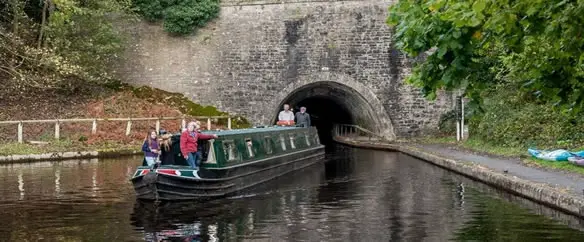
Fresh water & electricity onboard
Modern canal boats have all the usual amenities such as running hot and cold water and electricity. However be aware that not all boat types will be able to handle the load from your personal electronic items. Check with your boat supplier to see if your smart phone and laptop etc., can be properly powered onboard.
If you are visiting the European mainland you will need a different plug adaptor from the one you will need for the UK and Ireland.
In the event that you need to top up on water or fuel you will need to visit a boatyard. You will be advised of the procedure for this when you pick-up your boat though it is unlikely you will ever run low.
Mooring your boat
Mooring a canal boat is easy enough to do.
To start you will want to get your boat as close to the canal edge as possible before tying it up. To do this move the boat forward very slowly while pointing its front directly at the bank. Then use the boat’s reverse gear to stop the boat just before the front hits the bank.
Put the engine into neutral.
You will then use the line at the back of the boat to pull it in towards the bank before securing it. Most popular mooring spots will have bollards placed at strategic points with rings in them for tying your rope.
You will tie but the front of the boat and the back. On rivers be sure to secure the upstream first! And, be sure to leave a little slack in your ropes when you tie them.
Don’t worry about all the spots being taken as there are more than enough. There will usually be signposts indicating when you have entered a public mooring area. Some riverbanks, and many canals without towpaths, are not public property, some of them are privately owned and mooring there could be trespassing.
There are a few things to consider before you moor.
Don’t moor:
- Near locks
- Close to swing or lift bridges
- Near weirs
- Beside or close to sharp bends
- At blind spots where other boats will not see your boat until they’re right on top of it
- Near opposite turning points
- At junctions
- To the bank on a tidal river
- In spots that are marked for angling
- In a way where other boats can’t pass by yours
Obviously if you go to a boatyard to refuel or add fresh water etc., then the procedure will be different and you will be guided on what to do when you arrive there.
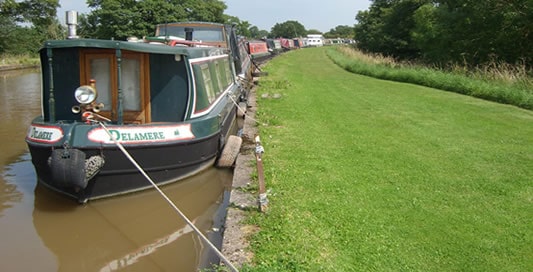
The difference between a canal boat and a narrowboat
I covered the differences, from an American point of view, between a canal boat and a narrow boat in this article. However, in Britain and Ireland a canal boat and a narrowboat are the same thing.
Why?
Because the canals are so narrow in the British Isles that only a narrowboat will fit in them.
Of course it is not uncommon to see a kayak, canoe or other small boat in British canals and you will see larger barges, widebeams and cabin cruisers in European canals as well as narrowboats. In American waters you can see all sorts of boats in canals.
Although there are a variety of different types of canal boats, most are long and not very wide but the one thing that all canal boats have in common is a shallow draft as they tend to traverse shallow waters.
The key difference between the different types of canal boats is their size and especially their width.
Although there are large canals in Britain, called “broad” or “wide” canals, most canals in the British Isles are very narrow. In fact, many aqueducts form part of the canal system in Britain and are so narrow that nothing wider than a canal boat will fit on them.
Because most British and Irish canals are very narrow, a narrowboat must be only 7 ft in width but can have a maximum length of 72 ft.
American canal boats come in a variety of widths and sizes as the canals tend to be much wider and deeper.

